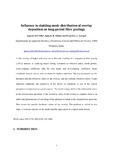Mostrar el registro sencillo del ítem
Influence in cladding mode distribution of overlay deposition on long-period fiber gratings
| dc.creator | Del Villar, Ignacio | es_ES |
| dc.creator | Matías Maestro, Ignacio | es_ES |
| dc.creator | Arregui San Martín, Francisco Javier | es_ES |
| dc.date.accessioned | 2018-04-06T06:10:38Z | |
| dc.date.available | 2018-04-06T06:10:38Z | |
| dc.date.issued | 2006 | |
| dc.identifier.issn | 1084-7529 (Print) | |
| dc.identifier.issn | 1520-8532 (Electronic) | |
| dc.identifier.uri | https://hdl.handle.net/2454/28196 | |
| dc.description.abstract | A thin overlay of higher refractive index than that of the cladding of a long-period fiber grating induces in cladding modes strong variations in effective index, mode profile, cross-coupling coefficient with the core mode, and self-coupling coefficient. Some conditions must be met in order to obtain the highest inducement. The key parameters are the thickness and the refractive index of the overlay, and the ambient refractive index. Under optimum conditions, the sensitivity of the device to variations in any of the critical parameters is improved in a great manner. The result is large shifts of the attenuation bands in the transmission spectrum. If the refractive index of the overlay is complex, there is an additional phenomenon of vanishing of the attenuation bands in the transmission spectrum. This occurs for specific thickness values of the overlay. The problem is solved in two steps: a vectorial analysis of the modes and the application of coupled-mode theory | en |
| dc.description.sponsorship | This work was supported by Spanish Ministerio de Cien- cia y Tecnología and Fondo Europeo de Desarrollo Re- gional research grants CICYT-TIC 2003-00909, Gobierno de Navarra, and a Formacion de Profesorado Universi- tario Ministerio de Educación Cultura y Deporte grant. | en |
| dc.format.mimetype | application/pdf | en |
| dc.language.iso | eng | en |
| dc.publisher | Optical Society of America | en |
| dc.relation.ispartof | Journal of the Optical Society of America A Vol. 23, Issue 3, pp. 651-658 (2006) | en |
| dc.rights | © 2006 Optical Society of America. One print or electronic copy may be made for personal use only. Systematic reproduction and distribution, duplication of any material in this paper for a fee or for commercial purposes, or modifications of the content of this paper are prohibited. | en |
| dc.subject | Long period fiber Bragg gratings | en |
| dc.subject | Optical fiber sensors | en |
| dc.subject | Thin-films | en |
| dc.subject | Coupled-mode theory | en |
| dc.title | Influence in cladding mode distribution of overlay deposition on long-period fiber gratings | en |
| dc.type | Artículo / Artikulua | es |
| dc.type | info:eu-repo/semantics/article | en |
| dc.contributor.department | Ingeniería Eléctrica y Electrónica | es_ES |
| dc.contributor.department | Ingeniaritza Elektrikoa eta Elektronikoa | eu |
| dc.rights.accessRights | Acceso abierto / Sarbide irekia | es |
| dc.rights.accessRights | info:eu-repo/semantics/openAccess | en |
| dc.identifier.doi | 10.1364/JOSAA.23.000651 | |
| dc.relation.publisherversion | https://doi.org/10.1364/JOSAA.23.000651 | |
| dc.type.version | Versión aceptada / Onetsi den bertsioa | es |
| dc.type.version | info:eu-repo/semantics/acceptedVersion | en |
| dc.contributor.funder | Gobierno de Navarra / Nafarroako Gobernua | es |


